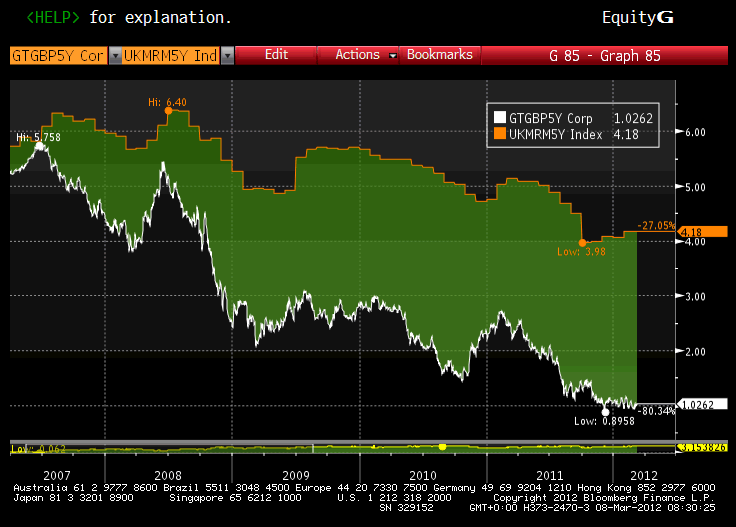The last three years have been one big transfer of wealth from savers to borrowers. Thanks to record low interest rates, savers have gained little from tucking their money away in bank accounts, whereas borrowers have reaped the benefits. According to data from the Bank of England, mortgage holders paid interest of £1328 billion in the three years from 2008-2011, compared to £1897 billion in the preceding three years. That’s a difference of £569 billion, or just over £50,000 for each of the UK’s 11.2 million mortgage holders. Call it a stimulus if you like. But it’s a stimulus that involves clobbering savers so that borrowers can buy a flatscreen TV at the end of the month.
There are signs, though, that this transfer is slowing. This is not because of anything that the Bank of England is doing, but because of the pressures facing the banking industry. Banks are still having funding difficulties, and the best quality and normally cheapest bank funds come from retail deposits – aka, savers. And so competition for retail deposits is increasing. In the last week, Halifax and Bank of Ireland have increased their standard savings rates. According to data from Defaqto, the average rate paid on a cash ISA has risen from 2.78 per cent to 3.35 per cent over the past two years. The banks are all trying to say to savers: ‘Deposit your money with us!’
We’re seeing a similar process with mortgages, to the detriment of borrowers. In the last few weeks, a number of banks have announced increases to the standard variable rates for their mortgages. Halifax is to increase its rate from 3.5 per cent to 3.99 per cent; RBS from 3.75 per cent to 4 per cent; Santander just a 0.1 percentage point increase; and Bank of Ireland from 2.99 per cent to 3.99 per cent. A Halifax spokesman explained it thus: ‘The increase to the rate reflects the fact that raising money through retail savings and in the wholesale markets is currently very expensive by historical standards.’
The chart below shows the yield on 5-year government bonds in white and the average borrowing costs for a 5 year fixed mortgage in orange. Clearly, the two borrowing costs move together – when the
gilt yield falls, mortgage costs fall, and vice versa. But note that since Autumn 2011 the average 5-year fixed mortgage rate has actually increased, whereas UK gilt yields have fallen. That has
not happened since 2007. So mortgage rates are increasing despite the gilt yield falling:
All of which is to say, the problems of the UK banking industry are helping to rebalance the position of savers and borrowers. British savers are seeing higher interest rates for their cash and
mortgage holders are having to pay higher costs for their debt. However, forecasters do not expect the Bank of England to increase rates for at least another two years, so any benefit to savers is
marginal at best. And if British homeowners have to pay more on their mortgages, then that is bad for the UK economy too, given that we are — thanks largely to debt — a home-owning
nation.
Hamlet’s Polonius may have said ‘Neither a borrower nor a lender be,’ but with base rates at 0.5 per cent, it is still best to be a borrower — even if the balance is shifting slightly.
Louise Cooper is a senior financial analyst at BGC Partners.






Comments